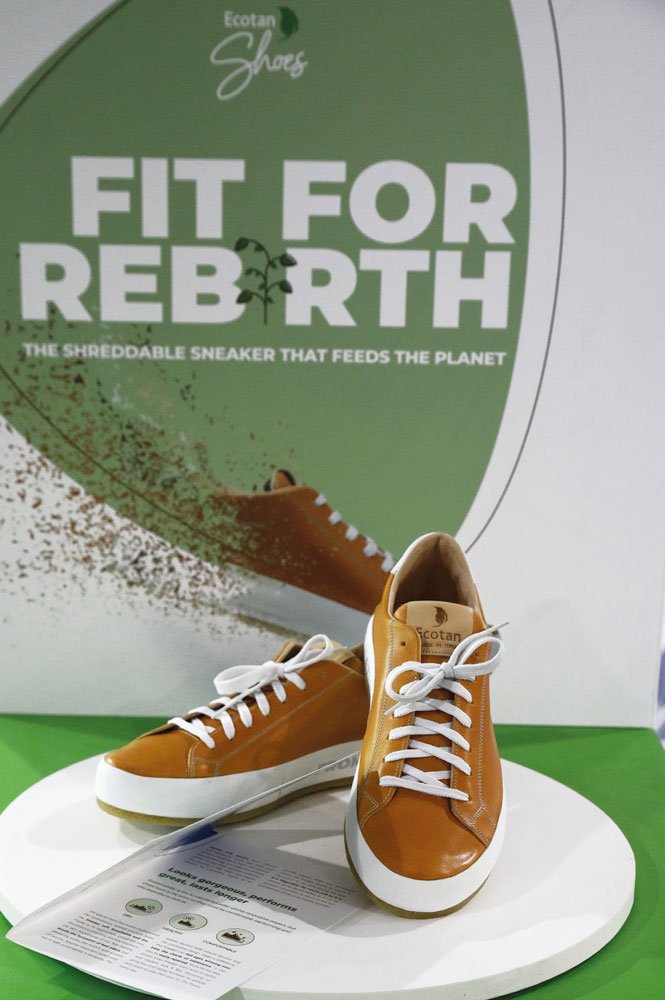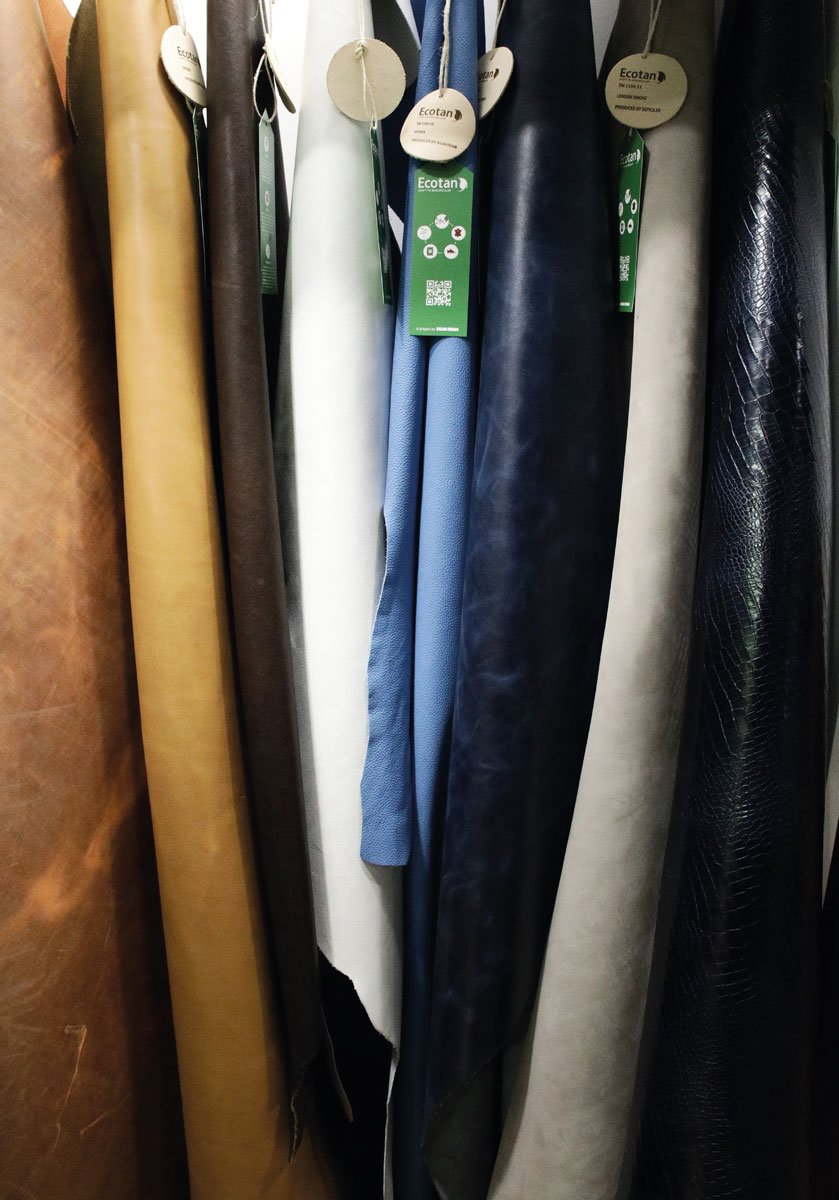Almost 25 billion pairs of shoes are produced every year worldwide, about 20 billion of which are sneakers (source: World Footwear). 95% of them end up in landfills within a year, and barely 5% are recycled. It is all too evident that this consumerist approach cannot be sustainable in any way.
Ecotan is the innovative Silvateam project that finally changes such approach: thanks to the great experience gained over the years with bio-circular leathers, Ecotan Shoes is born, a sustainable design philosophy able to rewrite the whole life cycle concept of footwear.
Antonio Battaglia, Leather Division Director of the Italian-based company, told us about this new type of tanning and Ecotan Shoes sneaker, explaining the benefits for the environment and for our health.
Let’s start from the beginning. Why does leather continue to be falsely demonised? “Over the years, leather has gone from being par excellence the most natural and beautiful material in the world to be considered less sustainable than plastic. The causes are various, but the hostility of vegans, who put the problem on an ethical rather than a sustainability level, does not help to improve the situation. Animal meat has always played a central role in the history and development of human societies. Today, 80% of the world’s population eats beef and 98% eats meat in general. I believe that this battle must be fought together, both by the food and tanning industries. I am also convinced that meat must be produced respecting animal rights, in an ethical and civil way, starting from breeding. Among other things, in recent decades, Silvateam has developed tannin-based formulations used successfully in animal nutrition. According to several studies carried out by prestigious universities and research centres, tannin is a natural antibacterial that is nowadays used to feed animals as a natural alternative to antibiotics, growth promoting drugs that have been adopted for over 50 years. Supplementing livestock diets with tannins permits to improve animal health and well-being, while counteracting the antibiotic resistance that threatens human health globally. We have adopted this philosophy also in the world of tanning, developing a cutting-edge and sustainable tanning technology. Leather has always been tanned with natural tannins and, for all this time, has been part of human evolution. Ecotan’s great technological innovation is the possibility of tanning leather without the use of chromium salts, other metals and harmful chemicals, such as glutaraldehyde, while leaving its softness and technical parameters unchanged as well as fully respecting the environment.”
How did the Ecotan leather concept come about? “We started well before the market asked for it. We were pioneers because we started working on this project as early as 2010. Natural tannins were mainly used in the tanning of the leather sole and vegetable-tanned leather, to make two beautiful but niche articles. On the one hand, our desire was to transfer the use of this type of leather into other sectors: automotive, footwear and leather goods, for example. On the other hand, we wanted to show that tannins are truly sustainable. We were convinced of this but, at the time, we did not have the necessary certifications yet. We had to work hard to prove it. Today we have, for the first time in the leather industry, the PEFC certification which ensures the sustainability of chestnut and quebracho tannins. Furthermore, the health aspect should not be overlooked. Initially we thought that tannin, being a natural antibacterial, could be useful in leather insoles and linings to promote the well-being of our feet while we wear shoes, avoiding the formation of unpleasant odours. Thus, we had in-depth studies carried out by the University of Milan and by Wellmicro, a spin-off of Bologna University, which revealed both in vitro and in vivo that tannins once inside the leather keep maintaining their antibacterial properties over time. When we think about it, tannins actually represent the natural defence of plants against viruses and bacteria.”
What feedback are you getting from the companies you are working with? “The feedback is very positive. It is exciting to work on this project. This is a sector that has always experienced a lot of distrust and closure. Thanks to this new project, important partnerships have been developed with different players along the entire supply chain, from tanneries, to companies specialised in leather finishing, waste management and laboratory analysis. Today we boast over 30 partner tanneries, in Italy, France, Portugal, Turkey, Mexico, Brazil, Argentina, South Korea and China. We are able to process different types of hides, such as bovine, sheep, goats and reptiles, in compliance with the technical and marketing specifications we share with all the participants in the project.”
What is the biggest challenge for you today? “I am convinced that now, moving from industrial trials to large-scale production will be a natural step. I believe that this technology will soon become a standard, the sustainable alternative to show that our industry wants to do things better. Our partners include the largest tanneries in the world and they have clearly decided to do things differently and efficiently. The initial technological challenge was to avoid upsetting the production process of the companies we work with.”
Ecotan Shoe: what is the philosophy of this innovative project? “The Ecotan Shoes sneaker is a revolutionary shoe, with an innovative design and featuring zero-waste, 100% ecological leathers, naturally tanned with tannins: the first truly bio-circular shoe that can be transformed into a fertiliser for organic farming at the end of its life. A project that shows how to fully return to nature those resources that were initially taken “on loan”. Designed in layers and without internal stitchings, the Ecotan Shoes sneaker is totally free of fillers, plastics or other synthetic polymers of fossil origin, thus proving to be a safe, clean and healthy solution for the consumer, as well as respectful for the environment. Thanks to its entirely organic origin, this sneaker is ‘digestible’ by nature as it is, without being disassembled. It can be completely shredded to be used as soil organic fertiliser, releasing the nutrients originally borrowed from the animal hide back into the soil. Rich in organic nitrogen and carbon, this fertiliser nourishes the planet, improving soil fertility and allowing plants to absorb and store CO2.”
Ecotan upcycling: why fertiliser and not compost? “Although Ecotan leathers are highly biodegradable, we have decided to stop further investigations because the path to follow would have been uncertain and full of potential issues. Biodegradability is usually assessed in materials such as paper or bioplastic, meaning that these tests are not exactly adaptable to analyse leather. Moreover, the undegradable residues of leather cannot become compost, which should be the natural end of life for a biodegradable product. The reason is that they do not match the parameters required for soil composition by several legislations, including the Italian one. On the contrary, the production of fertiliser is fully approved from a legal point of view, and vegetable tanned leather has been added in these formulations for over 100 years. I’m afraid that consumers picture biodegradability as a banana peel that gets transformed into compost. Unfortunately this idea is not transferable to leather.”
What will be the next step? “The interesting challenge now is to implement a complete bio-circular supply chain. What we currently offer is a process that is compliant with a certified leather upcycling system, which involves its transformation into a fertiliser for organic farming, thus preventing the leather from ending up in landfills or being incinerated. The Ecotan Shoes sneaker was an example to prove to brands that it is possible to create a 100% recyclable shoe that does not require to be disassembled to return to nature. To completely close the recyclability loop of Ecotan Shoes, the industry still needs to create collection centres where each of us can bring worn shoes, giving them a new life.”

From left: Alessandra Taccon, Eric Poles, Antonio Battaglia e Massimo Gotti at latest Lineapelle edition


